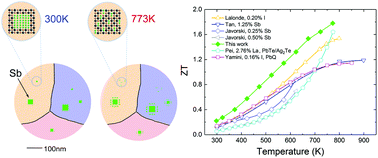Large enhancement of thermoelectric properties in n-type PbTe via dual-site point defects†
Abstract
The relatively inferior performance of n-type legs impedes the application of PbTe materials in intermediate temperature thermoelectric devices. In order to elevate the thermoelectric properties of n-type PbTe, we added some Sb phases into 0.1% PbI2-doped PbTe by a conventional melting method. Transmission electron microscopy (TEM) analysis together with density function theory (DFT) calculations showed that endotaxial Sb nanoprecipitates were produced in the PbTe samples at room temperature, and that part of these nanoprecipitates gradually dissolved into the PbTe matrix to form SbPb–SbTe dual-site substitutional point defects as temperature increased. A maximum ZT of about 1.8 was achieved at 773 K for the n-type PbTe0.998I0.002–3%Sb composite due to a simultaneous improvement in power factor and reduction in lattice thermal conductivity. In the PbTe0.998I0.002–x%Sb (x = 1–4) composite samples, the Seebeck coefficient was much higher than that of the reported single-phase PbTe samples with similar carrier concentration, which mainly originated from distortion of the density-of-states caused by Sb dual-site doping. Simulations based on the Callaway model suggested that the SbPb–SbTe dual-site substitutional point defects also played an important role in decreasing the lattice thermal conductivity at elevated temperature. We propose that the synergistic role of Sb in both electrical and thermal transport should be highly applicable in other bulk thermoelectric materials.



 Please wait while we load your content...
Please wait while we load your content...